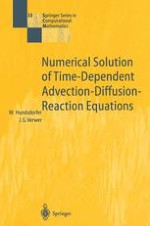This book deals with numerical methods for solving partial differential equa tions (PDEs) coupling advection, diffusion and reaction terms, with a focus on time-dependency. A combined treatment is presented of methods for hy perbolic problems, thereby emphasizing the one-way wave equation, meth ods for parabolic problems and methods for stiff and non-stiff ordinary dif ferential equations (ODEs). With regard to time-dependency we have at tempted to present the algorithms and the discussion of their properties for the three different types of differential equations in a unified way by using semi-discretizations, i. e. , the method of lines, whereby the PDE is trans formed into an ODE by a suitable spatial discretization. In addition, for hy perbolic problems we also discuss discretizations that use information based on characteristics. Due to this combination of methods, this book differs substantially from more specialized textbooks that deal exclusively with nu merical methods for either PDEs or ODEs. We treat integration methods suitable for both classes of problems. This combined treatment offers a clear advantage. On the one hand, in the field of numerical ODEs highly valuable methods and results exist which are of practical use for solving time-dependent PDEs, something which is often not fully exploited by numerical PDE researchers. Although many problems can be solved by Euler's method or the Crank-Nicolson method, better alter natives are often available which can significantly reduce the computational effort needed to solve practical problems.
